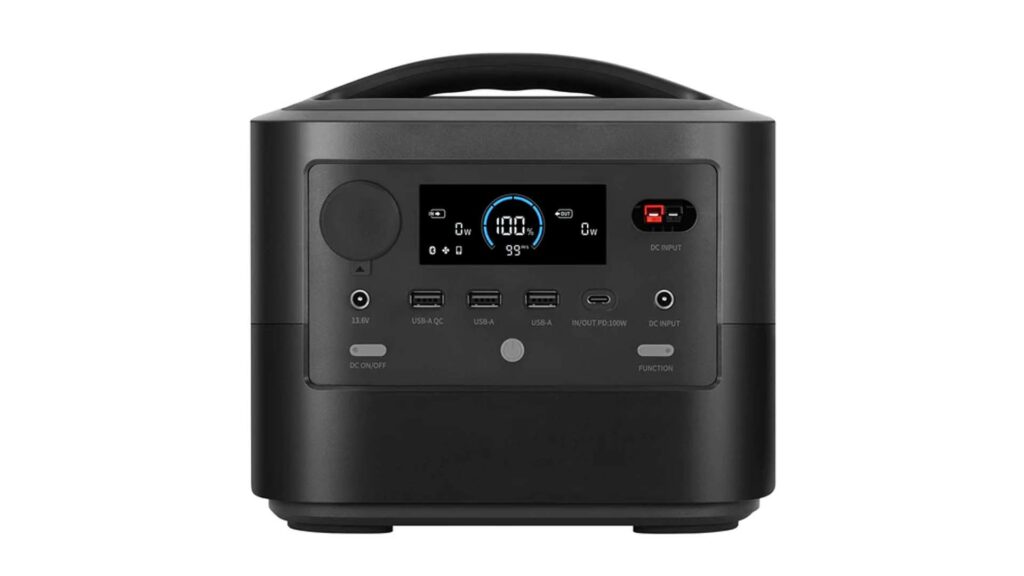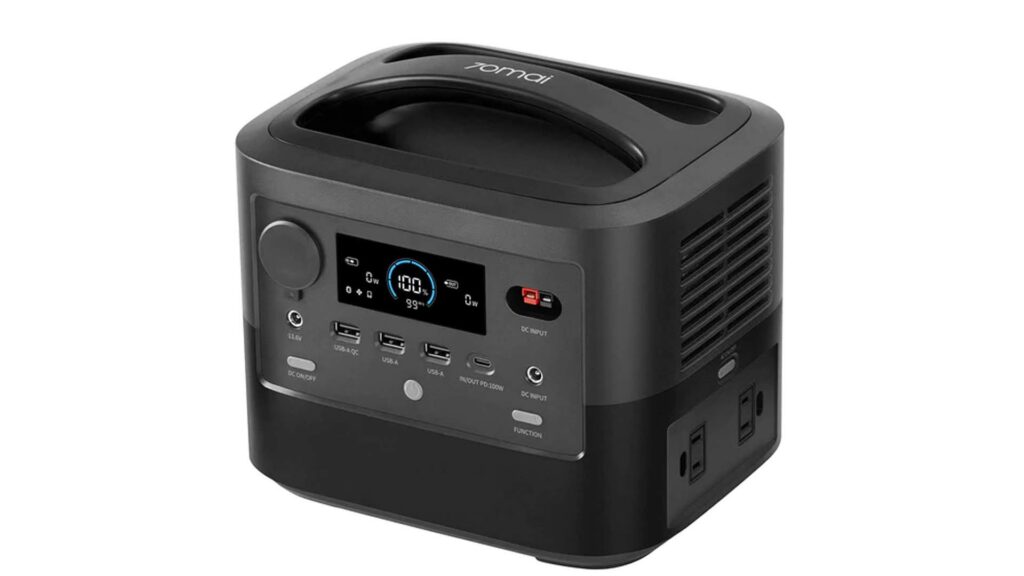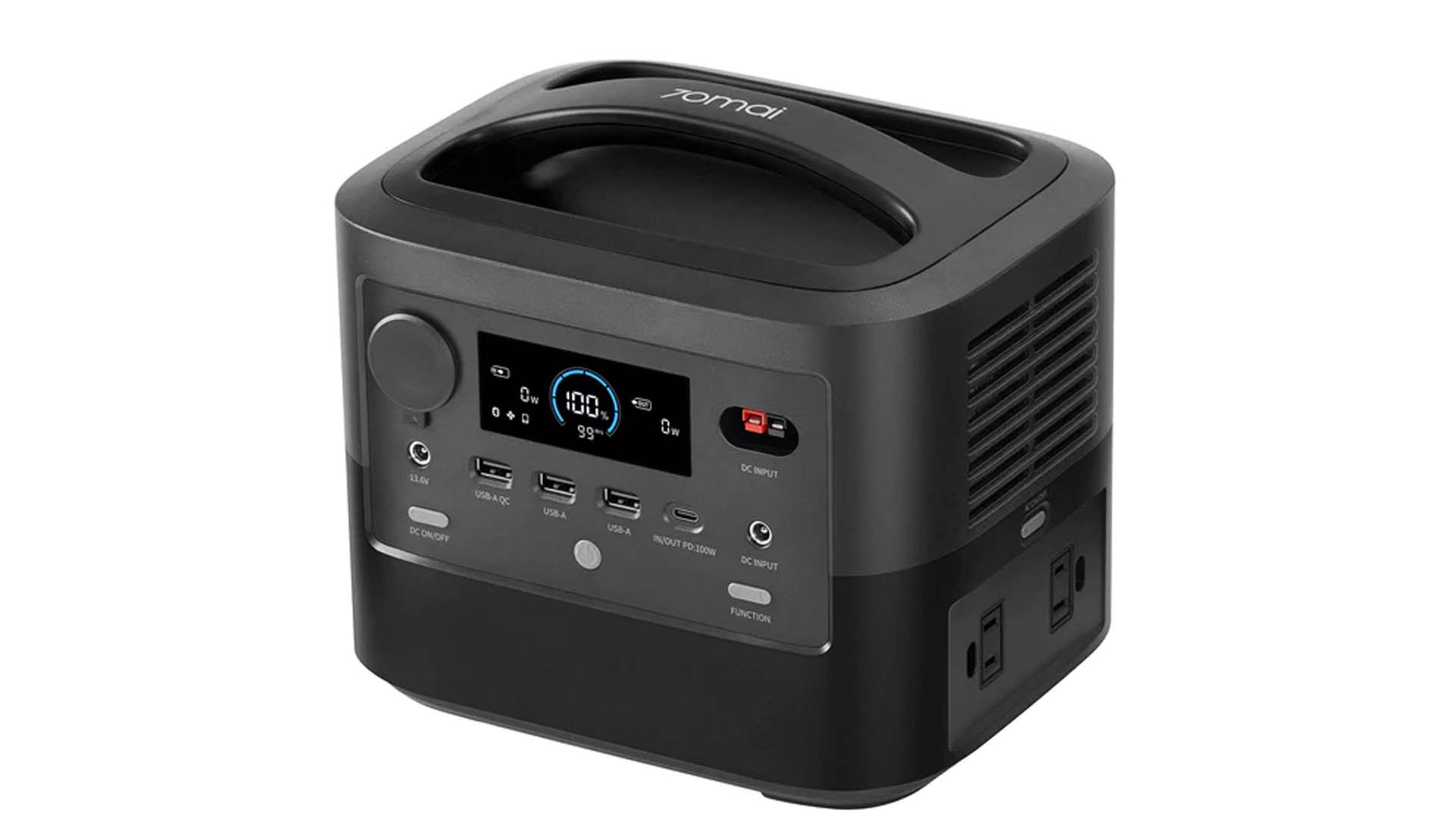Experience safer and more convenient travels with the 70mai Hiker 400 power station, boasting a dependable battery, robust AC inverter, and a handy backup flashlight. Seamlessly interact with the station’s front panel using the intuitive mobile app via an always-on Bluetooth interface.
Highlights:
- Utilizes Bluetooth low-energy technology
- Operates quietly
- Compact and lightweight design
Drawbacks:
- Requires an external power adapter
- NCM-based battery technology

Design of 70MAI HIKER 400
Upon purchase, the unit includes a 90W power adapter, a car charger, and a user manual. The presence of a curved handle facilitates easy portability, albeit at the expense of convenient storage.
The curved top design, while aiding in portability, limits the flat surface area for placing items like smartphones. Constructed with high-quality materials, the unit features four rubber pads at the bottom to prevent movement when connected to cables. Its dimensions are 22cm x 17.7cm x 19.7cm, weighing 3.9kg.
The front panel hosts the user interface, featuring a high-contrast segmented LCD for easy-to-read information with reduced power consumption. Essential metrics such as the power gauge are centrally displayed, with input and output power details refreshed every second. Icons indicating Bluetooth, Eco-mode, and timer functionalities are also present.
Controlled by five push buttons, including dual-purpose Power and Function buttons, the operation is intuitive. Power button functionality includes toggling the unit on/off with a long press, while a short press on Function activates Eco-mode. Bluetooth pairing is initiated with a long press on Function. Additionally, three buttons activate electrical sockets or the flashlight, all illuminating when active.
HIKER 400 supports three charging modes totaling 120W of input power. While USB Type-C charging remains convenient, it takes four hours to complete. Anderson and 5525 DC inputs support both 12V and 24V, facilitating a 100W solar panel use. The supplied 19V 90W power adapter offers the longest charging time.
The station provides four USB sockets, with a single Type-C supporting power distribution mode of up to 100W, along with three USB-A sockets offering 5V with a maximum power of 18W. Other DC outputs include a 5521 and a carport, delivering a regulated 13.6V supply at 10A—two 120V AC outputs supply 400W regularly, with a boost to 800W for short durations.
Specifications of HIKER 400
- Battery Chemistry: Lithium NCM
- Battery Capacity: 378Wh
- Number of Charge Cycles: Over 1000
- AC Output Power: 400W, Surge to 800W
- DC Output Power: 254W
- Number of AC Outlets: 2
- Number of DC Outlets: 5
- AC Inverter Efficiency: 74%
- Number of Power Inputs: 3
- Fastest Charge Time: 4 hours
- Additional Features: Bluetooth LE, Flashlight, ECO mode
- Weight: 3.9kg
- Volume: 7.7L
- Price: $399
70MAI HIKER 400: Utilization
The 70mai mobile app, compatible with Android and Apple devices, facilitates remote control of the station, requiring user registration. Installation instructions for the Hiker 400 are straightforward, easing setup. On the LCD, icons representing Bluetooth and smartphone modes signal the app’s connection status, which persists even after shutting down the station.
Equipped with Economic mode and power passthrough features, the Hiker 400 optimizes its compact design. In Economic mode (Eco), unused outputs are automatically turned off after a set time, conserving energy. Power passthrough utilizes the DC input to power connected devices, bypassing the Lithium battery and minimizing wear.
Efficiency testing involved the use of programmable AC and DC loads. While ideal efficiency is 100%, factors like internal heating and active cooling impact performance, resulting in an average efficiency of around 80%. The Hiker 400 achieves commendable efficiency rates, reaching 85% with DC output and dropping to 75% in AC mode due to fan operation. The fan emits approximately 45 dB of noise at a one-meter distance.
70MAI HIKER 400 vs. Competitors
Previously, portable power stations under 1000W were uncommon, mainly serving as emergency power sources for travel or home use. The Hiker 400 excels in this role due to its compact size and lightweight design. However, its battery chemistry presents challenges in temperatures as low as -10 degrees Celsius.
A formidable contender is the Bluetti EB3A, priced similarly to the Hiker 400. While it boasts Bluetooth capability, it lacks an Anderson input, restricting compatibility with certain solar panels. Additionally, its battery capacity is capped at 268Wh, limiting prolonged use.

70MAI HIKER 400: Final Assessment
Offering commendable battery capacity and inverter power within a compact frame, the Hiker 400 impresses with its versatility, notably enhanced by Bluetooth low-energy connectivity. The reliable connection between the device and paired smartphones enhances user experience, complemented by a well-crafted mobile app free from glitches. While achieving 75% efficiency in AC mode aligns with expectations for its price range, there’s room for improvement in battery chemistry, although the NMC type still ensures two years of full capacity despite daily charge cycles.
While the passthrough feature is appreciated, its 120W limitation leaves room for enhancement. The inclusion of an external power adapter, while functional, contrasts with competitor strategies aiming to minimize additional items for portability.

